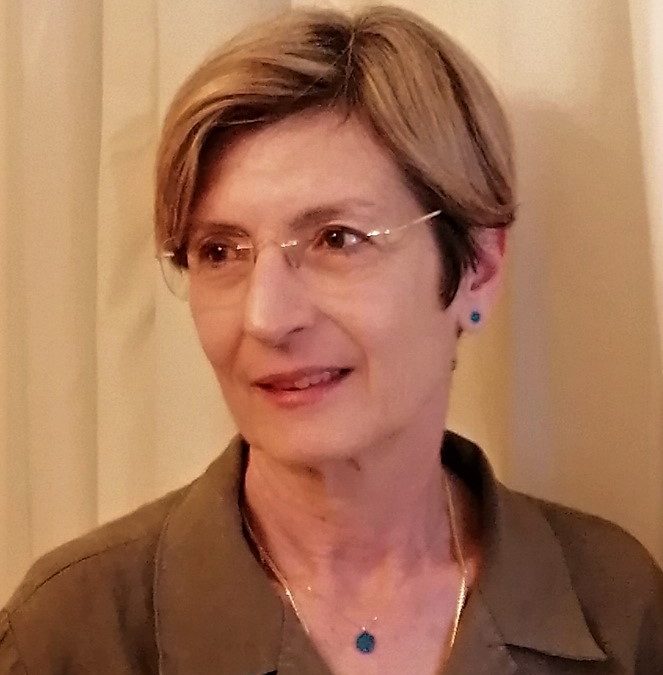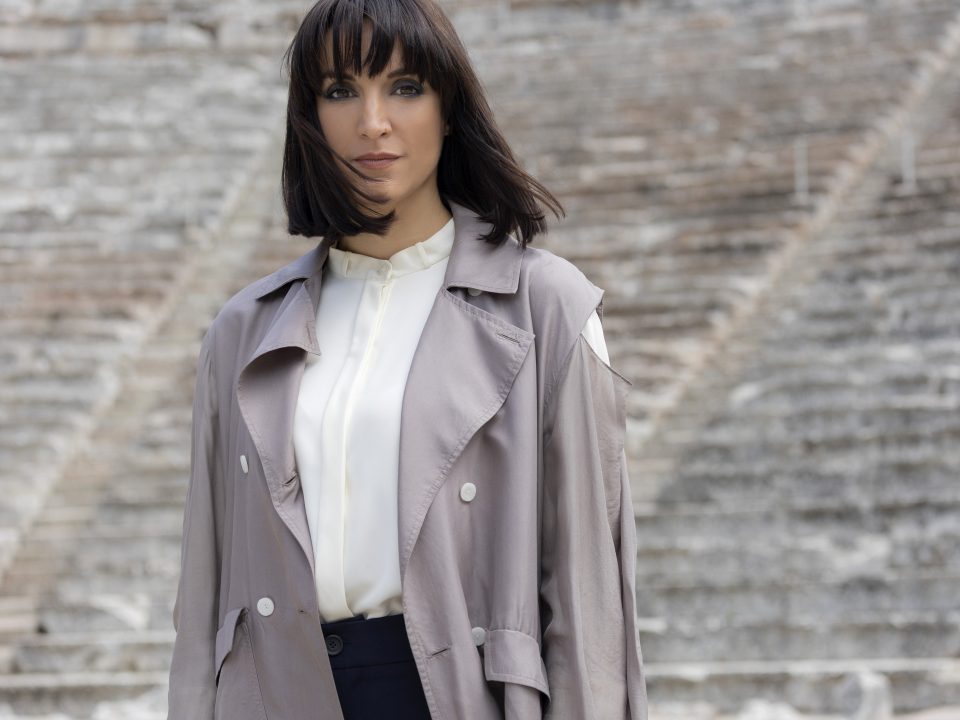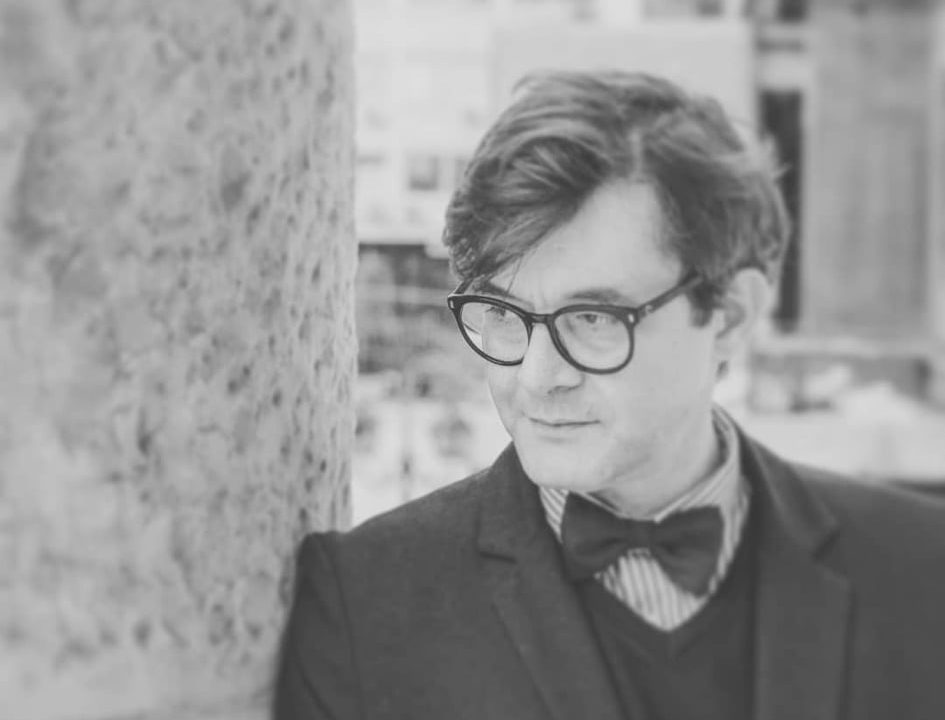Dr. Eleni Andrikou: “The Ephorate has plans to create a thematic route for the sanctuaries of Attica.”

Interview with archaeologist and Head of the Ephorate of Antiquities of East Attica,
Dr. Eleni Andrikou:

“The Ephorate has plans to create a thematic route for the sanctuaries of Attica.”
1. The Archaeological Museum of Brauron, built in 1962, houses the impressive finds from the systematic excavations at the Brauron sanctuary, as well as from wider area of Mesogaia, and is located a mere 200 meters from the archaeological site of the Sanctuary of Artemis Brauronia, one of the most important ancient sanctuaries of Attica. Talk to us about the advantages of its location.
The Sanctuary of Artemis at Brauron, is situated amidst a beautiful lush green landscape, on the banks of the Erasinos River. The location was obviously chosen precisely because of these characteristics that befit the worship of this Goddess as a protector of nature and fertility. However, human presence in the area has quite a long history, from prehistoric times up to the recent past, as the church of Agios Georgios to the southwest of the ancient sanctuary indicates. In 1948, when residents started digging to lay the foundations of the courtyard of the church of Agios Georgios, they brought to light the first archaeological evidence. This was followed by a systematic excavation by the archaeologist Ioannis Papadimitriou, interrupted in 1963 by his untimely death. The excavations revealed the monuments visible today on the site, namely the temple of Artemis preserved at foundation level, below the Agios Georgios church, the sacred spring, the large stoa that was partially restored, the north stoa, the so-called “tomb of Iphigenia” and others. Written sources inform us that the sanctuary contained even more buildings that are yet to be discovered and brought to light. Apart from the buildings, however, the excavations yielded a large number of finds, votive offerings to the Goddess, pieces from her cult statues, utensils and ceremonial objects. Therefore, the foundation of an Archaeological Museum on the grounds of the sanctuary was decided, to house and display the finds as evidence of the nature of the goddess’s worship, but also as works of art. The visitor thus gains a complete picture of the sanctuary and its operation, by combining the monuments in the archaeological site and the finds displayed in the Museum. In the Museum are also exhibited the finds from the prehistoric settlement on the adjacent hill of Kommeno Lithari and the neighbouring Mycenaean cemetery at Lapoutsi. This highlights the diachronicity of the human presence in this location. The Museum was founded in 1962 and was designed by distinguished architect Dimitrios Fotiadis.
2. The exhibits of the Museum include impressive finds from the systematic excavations of the sanctuary of Brauron as well as the wider area of Mesogaia. In your opinion, which are the exhibits that attract the most interest from visitors?
During the time period 2007-2009 the Museum was renovated, and the exhibition was organized in an innovative way, developing thematic units in each room. Thus, the history of the excavations is presented in the vestibule, in room 1 the diachronicity of the human presence in the sanctuary area from prehistoric to early Christian years and in room 2 the founding myth of the sanctuary and the rituals in honour of the goddess. Room 3 and room 4 present the world of children and of women respectively, since the core of the worship of Artemis at Brauron was the protection of women as wives and mothers and the preservation of their lives during pregnancy and childbirth, as well as the good health of the children. Particularly significant in terms of content and artistic value, is the “Relief of the Gods” in room 1, that depicts the myth of the founding of the sanctuary. This, as well as the votive reliefs representing the families coming to sacrifice to the goddess attract mostly the visitor’s interest. Personally, I would add the fragments of the cult statues of the goddess that were originally inside her temple, as they give a sense of their larger-than-life size. In the 3rd room, the attention is without doubt drawn by the statues of the children, mainly those exhibited in a row on a single pedestal, votive offerings of the parents to the Goddess. In the 4th room, every woman, at least, will view with interest all the objects either related to their daily activities, which were also protected by the Goddess, or those used for their personal grooming. I would like to make special reference to the wooden objects and artworks, as they are rare specimens from a nevertheless large category of objects, which were preserved at Brauron thanks to the swampy soil. However, the back of room 4 is dominated by the altar with a relief procession, led by Dionysus, a guest god at the sanctuary of Artemis. The last room of the Museum contains indicative finds from the numerous excavations that have taken place to date in Mesogaia – the wider area of the sanctuary – with representative samples from each Municipality.
3. What useful tips would you give to visitors regarding their tour of the Archaeological Museum of Brauron? The online purchase of tickets, free access days, multilingual information, accessibility etc. are factors that can increase a museum’s visitor numbers. Which of these “tools” does the museum of Brauron use and in what ways, in your opinion, could it be made even more attractive to visitors? Are there any plans to upgrade it and if so, what are they?
With the guidance of the antiquities guards, visitors can tour the museum in the order mentioned above, in order to understand the history of the site and the function of the sanctuary. Short bilingual (Greek – English) introductory texts in each section-room and descriptions for each exhibit help the visitor to this end. Information about the Archaeological Museum and the Site is posted on the ODYSSEUS website of the Ministry of Culture (www.odysseus.culture.gr) and soon on the Ephorate’s website, for those visitors who wish to prepare before their visit. Also, the bilingual leaflet of the Museum and of the site will be posted on the Ephorate’s Facebook page (www.facebook.com/efaanat). A visit to the site is also necessary, before or after touring the Museum. The ticket covers both, and it is issued at the Museum. Payment should be preferably made by credit or debit card. We hope to make e-tickets and their online purchase available in the near future, with the programme gradually expanding to cover all archaeological sites and museums.
Entrance to the Museum and the site is free of charge on the first Sunday of the months between November-March, and on specific days, such as the International Day of Museums, Green Cultural Routes, European Days of Cultural Heritage, the European Day of Conservation, when special educational programmes, tours and other activities are organised, which are announced on the Facebook page of the Ephorate. Discounted tickets are also available for a number of categories of visitors.
As I already noted, the Archaeological Museum at Brauron has already adjusted to modern museological perceptions. But since it is a living organism, the services offered are constantly renewed, with educational programmes addressed mainly to schools, as well as tours on all the days I mentioned before, while at regular intervals one exhibit is selected to be showcased – mainly from the Ephorate’s recent excavations – or one activity, in the context of an action called “Unknown finds – hidden treasures”. These temporary exhibitions are accompanied by videos posted on the Ephorate’s facebook.
In this context, the Ephorate has added copies of important sculptures (Relief of the Gods in Room 1 and children’s statues in Room 3) as tactile objects for people with impaired vision. These are exact copies made by the workshops of the Hellenic Organization of Cultural Resources Development.
At the same time, all of the Museum’s recent activities can be found on the Ephorate’s Facebook page.
4. The Archaeological Museum of Brauron is considered ideal for school visits. What factors do you think make it “child friendly”? Are the unique location in which it is built, the mythological paths that young visitors can explore through its exhibits, the Sanctuary of the Goddess Artemis, protector of children, pregnant women, arts and weaving, located within walking distance from the Museum, incentives for students and how can they be further leveraged? Are there any programmes or activities in the Museum specifically addressed to children?
The Archaeological Museum of Brauron is a favourite of children, as they can easily see the links between their present and the past by comparing themselves with the children of antiquity, especially in room 4 where the statues of children – votive offerings to their protector Artemis – are exhibited. The natural environment that surrounds the Museum as well as the archaeological site are a breath of fresh air for children, especially those living in urban centres. The educational programmes offered by the Ephorate on a weekly basis for the schoolchildren of Primary education and the guided tours for the pupils of Secondary education are also very popular.
The subjects of the educational programmes cover the properties of the Goddess and less-known aspects of her cult. Some such titles are: Artemis Light-bearer, The fairytale of Artemis – From the sanctuary of Artemis of Brauron to the Early Christian Basilica, The journey of Iphigenia – The founding of the sanctuary. A programme for the entire family was launched in 2019 on the art of weaving in antiquity with the upright loom, since Artemis was a patron of women’s handicrafts. Another programme is the “Leisure and free time – Playing in antiquity”, as toys are common finds at the Brauron sanctuary. The enthusiastic response of schoolchildren and teachers and the fact that the same schools seek to visit and participate in our programmes each year, are encouraging for us, as we see an audience forming with an interest in the past lives of people and their multiple secrets which the exhibits of the Museum can narrate.
5. Mythology is appealing not only to Greeks but also to foreign visitors. Could you tell us a few words about the mythological past of Brauron, in which the goddess Artemis holds a leading role?
There are two main myths about the sanctuary of Artemis of Brauron. The first has to do with the founding of the sanctuary. It begins with the sacrifice of Iphigenia in Aulis, from where the goddess snatched her at the last moment and took her to Tauris (Crimea) and made her a priestess in her temple. As we learn from Euripides (Iphigenia in Tauris 414-413 BC), the goddess Athena ordered Orestes to travel to Tauris to retrieve his sister Iphigenia. Together they had to carry the ancient statue of the goddess, the xoanon, to the temple of Artemis Tauropolos in modern-day Artemida (Loutsa), while Iphigenia would remain in the sanctuary at Brauron throughout her lifetime, as a key-holding priestess. In another version of the myth by traveller Pausanias (2nd century AD), shown in the Relief of the Gods in Room 1 of the Museum, the order was to take the xoanon to Brauron.
The second important myth is related to the content of the cult and the rituals. Artemis, as protector of animals and nature in general, had a tame bear on her side. One day, as the bear was playing with a young girl, it accidentally injured her, by scratching her on the cheek. When her brothers saw the wound, they killed the bear to punish it. This sacrilegious act brought the wrath of the Goddess upon them, who sent pestilence and drought to the region. The residents went to an oracle to find out what the cause of their misfortune was, and they were given the following prophecy: the prominent families of Athens had to take their young daughters, up to 10 years old, to the Brauron sanctuary, where they would stay for a short period of time to be prepared for their future life as wives and mothers. While they remained at the sanctuary, the young girls were called arktoi (bears) and their time there artkeia. The arktoi took part in the procession of the great Brauronia Festival, all the way from Brauron to the Acropolis of Athens. The arkteia was a coming of age ceremony, signalling the end of childhood.
6. How important is the archaeological heritage of Attica for tourism and how can it be combined with its modern culture? Do you believe that ancient and contemporary art in Attica can be in a dialogue with each other?
Attica is world-famous thanks to the Acropolis of Athens, the battle of Marathon (480 BC) and the temple of Poseidon at Sounio. However, it has many more archaeological sites, significant ones, which the Greek State is promoting, such as Brauron, the sanctuary of the Egyptian Gods at Nea Makri, the sanctuary of Amphiaraus at Kalamos, the silver mines in Lavreotiki peninsula or others which are to be included in preservation programs, such as the ancient cities of Thoriko and Rhamnous. These sites, thanks to the guided tours and the educational programs of the Ephorate, have an ever-expanding domestic audience. They should however be promoted more intensely and be included in tourist routes, potentially through the cooperation of the State with the tourism professionals. All the sites are situated in landscapes of outstanding natural beauty which are largely protected that can offer multiple experiences to visitors. Many artists, being the most sensitive recipients of messages, are inspired by these landscapes and create mainly visual works of art. Especially for Brauron, the Ephorate has agreed on a partnership to create an artistic intervention that respects the site and its essence, but which was suspended due to the pandemic.
7. What other activities in the area could one combine with a visit to the Archaeological Museum of Brauron?
The Archaeological Site and the Museum of Brauron are in an area that is ideal for trekking or bicycle riding, while there are also the beaches of Porto Rafti, Chamolia, Artemida (Loutsa) nearby, for those who prefer swimming. In the area of Brauron there are several wineries for wine tourism and on the beaches you can enjoy your coffee or the delicacies of a taverna. Another suggestion of the Ephorate, in order to increase tourist traffic in the archaeological site and the Museum, but also in the wider area of Brauron, is to offer the option to travellers in transit at the Athens International Airport to take advantage of any layover time, to get one last taste of our country at sites nearby the airport. Finally, the Ephorate has plans to create a thematic route for the sanctuaries of Attica (Sounio – Brauron – Nea Makri – Rhamnous – Amphiareion).
8. The Museum is within a stone’s throw of the Brauron wetland, which is one of the two unique wetlands of Attica included in the NATURA 2000 Network. What, in your opinion, are the benefits of this proximity?
The Brauron wetland is an integral part of the archaeological site. As I said before , the sanctuary was founded in this environment, because this is what the character of this Goddess dictated. However, the sanctuary was probably abandoned in the 3rd century B.C. because of the Erasinos river, which was probably flooding more frequently and more severely. It was listed as an archaeological site in 1957, including the wetland, and its protection based on Law 5351/1932 “On Antiquities” and the successor Law 3028/2002, as well as the expropriations carried out by the Ministry of Culture after the discovery of the sanctuary from the 1950s onwards, were decisive actions for the protection of the environment, as has happened in many other cases, such as – to mention the most prominent – Delphi and Olympia. Its inclusion in the NATURA 2000 network further contributes to the protection of the natural environment. In recent years, the cooperation of the Ephorate with the Hellenic Ornithological Society (www.ornithologiki.gr) has resulted in complementary actions, such as tours and educational activities, allowing participants to form a fuller picture of the cultural/archaeological and natural environment.




